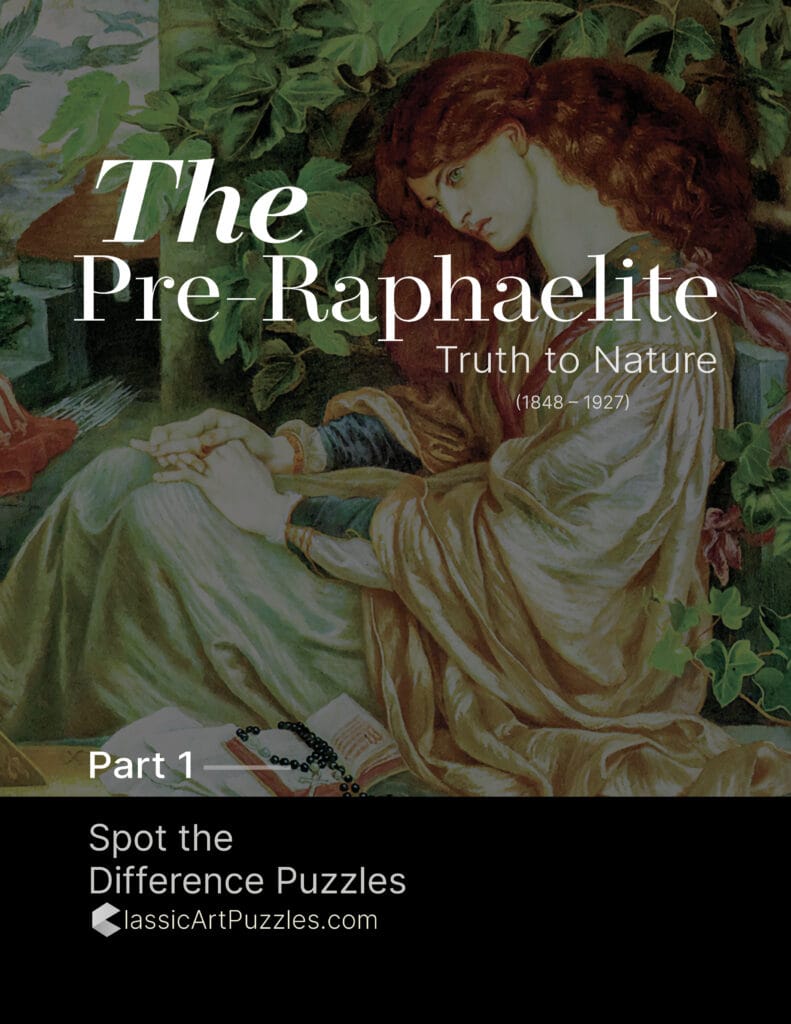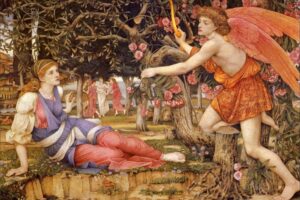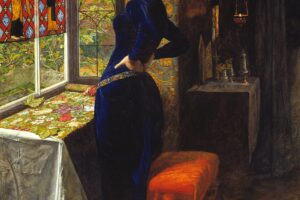Table of Contents
Overview
The Sleeping Beauty (1921) by John Collier is a richly imagined retelling of the legendary fairy tale. The princess lies motionless on a carved wooden bed, her embroidered gown glowing with floral patterns, her golden hair flowing like sunlight. Around her, two maidens keep vigil in sorrow, their rich red and blue garments deepening the scene’s solemn beauty. Beyond the stained-glass windows, autumn trees whisper of time’s slow passing.
John Collier (1850–1934), though often grouped with the late Pre-Raphaelites, bridged Victorian narrative painting with early 20th-century romanticism. In this work, he brought together his gift for portraiture, mythic storytelling, and meticulous craftsmanship.
Exhibited in the 1920s, Collier’s version of the tale captured both nostalgia for Pre-Raphaelite romanticism and modern fascination with psychological depth. Today, the painting stands as one of his most enduring images, a vision of enchantment, patience, and the eternal power of story.
About the Artist

John Collier (1850–1934) was a British painter and writer closely associated with the later Pre-Raphaelite and academic traditions. Trained at the Slade School and in Paris, he became known for portraits, historical subjects, and literary themes. While rooted in realism, his works often carried a romantic or psychological intensity, blending Pre-Raphaelite detail with Edwardian refinement. He also authored influential books on art, helping bridge Victorian aesthetics with modern sensibilities.
The Story Behind the Painting
A Fairy Tale Retold
The story of Sleeping Beauty, drawn from Charles Perrault and the Brothers Grimm, tells of a princess cursed to slumber for one hundred years until awakened by love’s kiss. Collier chooses to depict not the moment of awakening but the stillness of enchantment itself — a suspended world between time and eternity.
Victorian and Edwardian Fascination
For Victorians and their descendants, fairy tales carried moral and symbolic power. They were not simply children’s stories but allegories of patience, destiny, and transformation. Collier’s Sleeping Beauty reflects this cultural lens: the princess embodies innocence preserved, while her attendants represent mourning, hope, and faith in renewal.
Pre-Raphaelite Influence
Though painted decades after the original Brotherhood, the work echoes Pre-Raphaelite ideals: intense color, symbolic detail, and narrative clarity. It shows how the movement’s influence lingered well into the early 20th century.
Composition and Subjects
The Sleeping Princess
At the center lies the princess, her embroidered gown bursting with floral motifs. Her golden hair spreads across the pillow, her face serene, embodying timeless innocence and beauty untouched by time.
The Vigil of the Maidens
To the left and right sit two maidens — one in red, head bowed, the other in blue, leaning on the bed in sorrow. Their positions reflect grief, devotion, and the endurance of companionship through long waiting.
The Interior Setting
The stained-glass windows, patterned tapestries, and dark wood furniture ground the fairy tale in Gothic medieval atmosphere. They suggest both the weight of tradition and the solemnity of suspended time.
Symbolic Richness
The embroidered gown is key: its blossoming motifs symbolize life dormant yet not extinguished, mirroring the princess’s slumber as a pause, not an ending.
Art Style and Techniques
Romantic Realism
Collier employs academic precision in rendering textures — the tapestry, embroidery, stained glass — yet suffuses the scene with romantic atmosphere, making it more than a historical interior.
Color Symbolism
The triad of colors dominates: red for passion and life’s flame, blue for sorrow and devotion, gold for divinity and hope. These hues harmonize to weave the painting’s emotional fabric.
Pre-Raphaelite Legacy
Though painted in 1921, the jewel-like detail and symbolic intensity recall the Pre-Raphaelites, showing the endurance of their aesthetic into the new century.
Legacy and Reflection
Reception
By the 1920s, Pre-Raphaelitism had faded from the forefront of art, but works like Collier’s Sleeping Beauty kept its spirit alive. The painting was admired for its beauty and narrative clarity, resonating with a public still drawn to fairy tales as both entertainment and allegory.
Enduring Significance
Today, the painting is seen as a late flowering of Pre-Raphaelite romanticism. It continues to enchant viewers, reminding us that stories of love, waiting, and awakening never lose their power.
Featured in Our Collection
The Sleeping Beauty is included in our Pre-Raphaelite Spot-the-Difference Puzzle Flipbook. Its embroidered gown, rich colors, and layered symbolism make it a captivating puzzle subject. Through interactive play, you can explore Collier’s detail and rediscover the timeless magic of fairy tale romance.
Dreaming in the Gown of Flowers
The princess lies in silence, her companions keep vigil, and time holds its breath. In The Sleeping Beauty, Collier turns fairy tale into vision, where waiting becomes poetry and love is promised beyond sleep.




